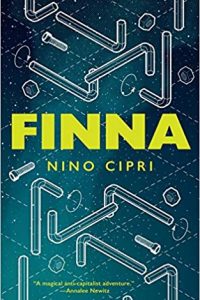Gary K. Wolfe Reviews Starling House by Alix E. Harrow
 Starling House, Alix E. Harrow (Tor 978-1-25079-905-0, $28.99, 320pp, hc) October 2023.
Starling House, Alix E. Harrow (Tor 978-1-25079-905-0, $28.99, 320pp, hc) October 2023.
Alix E. Harrow is also acutely aware of the traditions behind Starling House, as evidenced by her epigraph from Wuthering Heights and a few passages – including the opening line – that sound like they might have come from du Maurier’s Rebecca. But Harrow’s narrator, a 26-year-old dropout named Opal, has a tough, witty, hardscrabble voice that would hardly be recognized by traditional Gothic heroines, and her setting is the equally hardscrabble town of Eden, Kentucky, hanging on long after the coal mines that sustained it have played out. In the first few chapters, the author who unexpectedly popped into mind has nothing at all to do with haunted houses or the Southern Gothic tone of the rest of the book: Barbara Ehrenreich, whose famous accounts of the American underclass seem reflected in Opal’s desperate poverty and her dreams of providing a better life for her gifted but asthmatic younger brother Jasper. With her mother long deceased and her father a complete mystery, she works a part-time job a four-mile walk (she can’t afford a car) from the cheap motel where she and her brother are permitted to live, ostensibly because of a bet her mother made prior to her death. ‘‘People like me have to make two lists: what they need and what they want’’, she tells us. ‘‘You keep the first list, if you’re smart, and you burn the second one.’’ These dire circumstances provide a thoroughly credible motivation for Opal’s eventual involvement with Starling House, the crumbling mansion on the edge of town which – of course – is shunned by all the locals.
Opal has dreamed about the house since childhood, and was fascinated by a 19th-century children’s fantasy called The Underland, the only work by Eleanor Starling, who had inherited the house under suspicious circumstances after marrying into the coal-wealthy Gravely family, and subsequently disappeared into it. Stopping by the gates of the house on her way home from work, Opal meets the reclusive current heir, Arthur Starling. As the point of view shifts between Opal’s first-person narration and Arthur’s third-person, we learn that Arthur views himself as fulfilling a kind of sacred mission to be the last ‘‘Warden’’ of the house–but the house seems to have its own notions about that. Meanwhile, Opal grows so persistent that Arthur eventually offers her a job as a housecleaner. As Opal develops her own relationship with the house – which, we soon learn, not only has a mind of its own but is prone to some serious mood swings – her story inevitably grows entwined with Arthur’s, with the town’s dark history, with her own family background, and even with the secrets of that old children’s book The Underland.
Opal and Arthur are a far cry from Heathcliff and Cathy, just as Kentucky coal country is a far cry from the Yorkshire moors, but sense of place is a strength of Harrow’s fiction, and the town of Eden provides a kind of real-world grounding rare in traditionally claustrophobic haunted house tales. Opal’s fierce devotion to her brother Jasper gives her a clear focus in the world outside Starling House, and a subplot involving her only real allies in town, the local librarian and the owner of the motel where she lives, folds into the main narrative in neat and satisfying ways. Starling House may seem like quite a departure from Harrow’s expansive The Ten Thousand Doors of January, the historical detail of The Once and Future Witches, or her recent lively fairy tale redactions, but there’s a certain kind of sharply intelligent, defiant, and resourceful voice, usually belonging to a young woman facing daunting odds, that gives her fiction a consistent and consistently appealing tone. Opal may be the most appealing such figure yet, and her story is genuinely haunting in a way that has little to do with ghosts or demons.
Gary K. Wolfe is Emeritus Professor of Humanities at Roosevelt University and a reviewer for Locus magazine since 1991. His reviews have been collected in Soundings (BSFA Award 2006; Hugo nominee), Bearings (Hugo nominee 2011), and Sightings (2011), and his Evaporating Genres: Essays on Fantastic Literature (Wesleyan) received the Locus Award in 2012. Earlier books include The Known and the Unknown: The Iconography of Science Fiction (Eaton Award, 1981), Harlan Ellison: The Edge of Forever (with Ellen Weil, 2002), and David Lindsay (1982). For the Library of America, he edited American Science Fiction: Nine Classic Novels of the 1950s in 2012, with a similar set for the 1960s forthcoming. He has received the Pilgrim Award from the Science Fiction Research Association, the Distinguished Scholarship Award from the International Association for the Fantastic in the Arts, and a Special World Fantasy Award for criticism. His 24-lecture series How Great Science Fiction Works appeared from The Great Courses in 2016. He has received six Hugo nominations, two for his reviews collections and four for The Coode Street Podcast, which he has co-hosted with Jonathan Strahan for more than 300 episodes. He lives in Chicago.
This review and more like it in the September 2023 issue of Locus.
 While you are here, please take a moment to support Locus with a one-time or recurring donation. We rely on reader donations to keep the magazine and site going, and would like to keep the site paywall free, but WE NEED YOUR FINANCIAL SUPPORT to continue quality coverage of the science fiction and fantasy field.
While you are here, please take a moment to support Locus with a one-time or recurring donation. We rely on reader donations to keep the magazine and site going, and would like to keep the site paywall free, but WE NEED YOUR FINANCIAL SUPPORT to continue quality coverage of the science fiction and fantasy field.
©Locus Magazine. Copyrighted material may not be republished without permission of LSFF.





